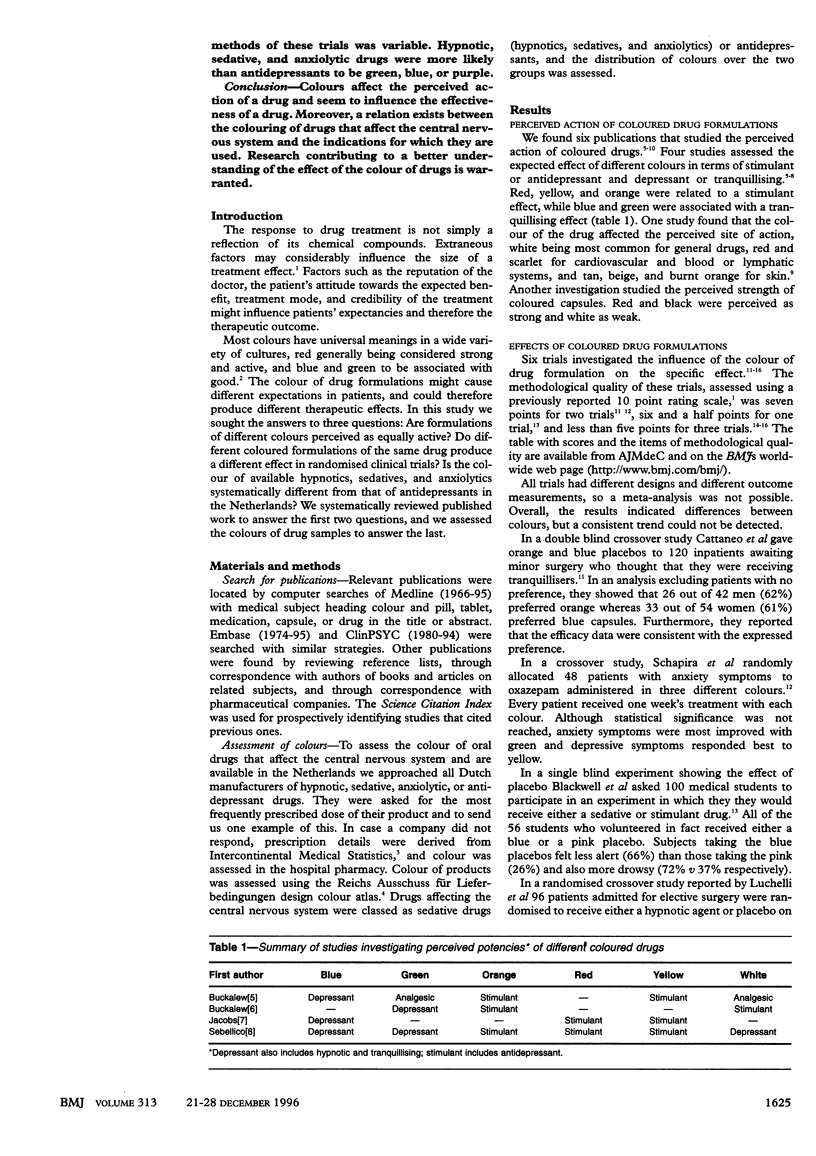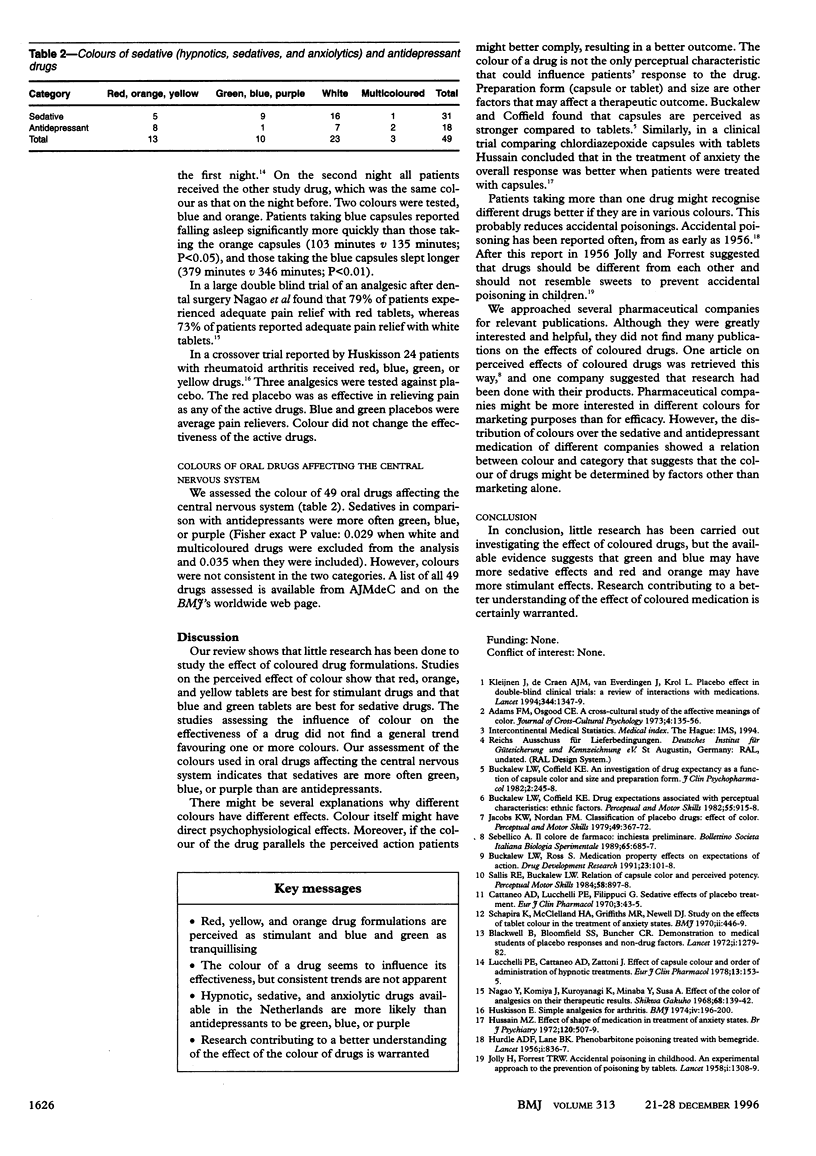Abstract
OBJECTIVE: To assess the impact of the colour of a drug's formulation on its perceived effect and its effectiveness and to examine whether antidepressant drugs available in the Netherlands are different in colour from hypnotic, sedative, and anxiolytic drugs. DESIGN: Systematic review of 12 published studies. Six studies examined the perceived action of different coloured drugs and six the influence of the colour of a drug on its effectiveness. The colours of samples of 49 drugs affecting the central nervous system were assessed using a colour atlas. MAIN OUTCOME MEASURES: Perceived stimulant action versus perceived depressant action of colour of drugs; the trials that assessed the effect of drugs in different colours were done in patients with different diseases and had different outcome measures. RESULTS: The studies on perceived action of coloured drugs showed that red, yellow, and orange are associated with a stimulant effect, while blue and green are related to a tranquillising effect. The trials that assessed the impact of the colour of drugs on their effectiveness showed inconsistent differences between colours. The quality of the methods of these trials was variable. Hypnotic, sedative, and anxiolytic drugs were more likely than antidepressants to be green, blue, or purple. CONCLUSIONS: Colours affect the perceived action of a drug and seem to influence the effectiveness of a drug. Moreover, a relation exists between the colouring of drugs that affect the central nervous system and the indications for which they are used. Research contributing to a better understanding of the effect of the colour of drugs is warranted.
Full text
PDF


Selected References
These references are in PubMed. This may not be the complete list of references from this article.
- Blackwell B., Bloomfield S. S., Buncher C. R. Demonstration to medical students of placebo responses and non-drug factors. Lancet. 1972 Jun 10;1(7763):1279–1282. doi: 10.1016/s0140-6736(72)90996-8. [DOI] [PubMed] [Google Scholar]
- Buckalew L. W., Coffield K. E. An investigation of drug expectancy as a function of capsule color and size and preparation form. J Clin Psychopharmacol. 1982 Aug;2(4):245–248. [PubMed] [Google Scholar]
- Buckalew L. W., Coffield K. E. Drug expectations associated with perceptual characteristics: ethnic factors. Percept Mot Skills. 1982 Dec;55(3 Pt 1):915–918. doi: 10.2466/pms.1982.55.3.915. [DOI] [PubMed] [Google Scholar]
- HURDLE A. D., LANE B. K. Phenobarbitone poisoning treated with bemegride. Lancet. 1956 Jun 2;270(6927):836–837. doi: 10.1016/s0140-6736(56)91301-0. [DOI] [PubMed] [Google Scholar]
- Huskisson E. C. Simple analgesics for arthritis. Br Med J. 1974 Oct 26;4(5938):196–200. doi: 10.1136/bmj.4.5938.196. [DOI] [PMC free article] [PubMed] [Google Scholar]
- Hussain M. Z. Effect of shape of medication in treatment of anxiety states. Br J Psychiatry. 1972 May;120(558):507–509. doi: 10.1192/bjp.120.558.507. [DOI] [PubMed] [Google Scholar]
- JOLLY H., FORREST T. R. Accidental poisoning in childhood; an experimental approach to the prevention of poisoning by tablets. Lancet. 1958 Jun 21;1(7034):1308–1309. doi: 10.1016/s0140-6736(58)92064-6. [DOI] [PubMed] [Google Scholar]
- Jacobs K. W., Nordan F. M. Classification of placebo drugs: effect of color. Percept Mot Skills. 1979 Oct;49(2):367–372. doi: 10.2466/pms.1979.49.2.367. [DOI] [PubMed] [Google Scholar]
- Kleijnen J., de Craen A. J., van Everdingen J., Krol L. Placebo effect in double-blind clinical trials: a review of interactions with medications. Lancet. 1994 Nov 12;344(8933):1347–1349. doi: 10.1016/s0140-6736(94)90699-8. [DOI] [PubMed] [Google Scholar]
- Lucchelli P. E., Cattaneo A. D., Zattoni J. Effect of capsule colour and order of administration of hypnotic treatments. Eur J Clin Pharmacol. 1978 May 17;13(2):153–155. doi: 10.1007/BF00609760. [DOI] [PubMed] [Google Scholar]
- Sallis R. E., Buckalew L. W. Relation of capsule color and perceived potency. Percept Mot Skills. 1984 Jun;58(3):897–898. doi: 10.2466/pms.1984.58.3.897. [DOI] [PubMed] [Google Scholar]
- Schapira K., McClelland H. A., Griffiths N. R., Newell D. J. Study on the effects of tablet colour in the treatment of anxiety states. Br Med J. 1970 May 23;1(5707):446–449. doi: 10.1136/bmj.2.5707.446. [DOI] [PMC free article] [PubMed] [Google Scholar]


